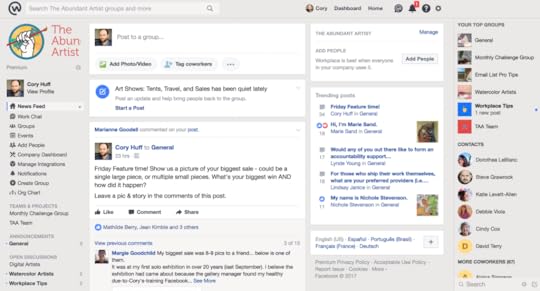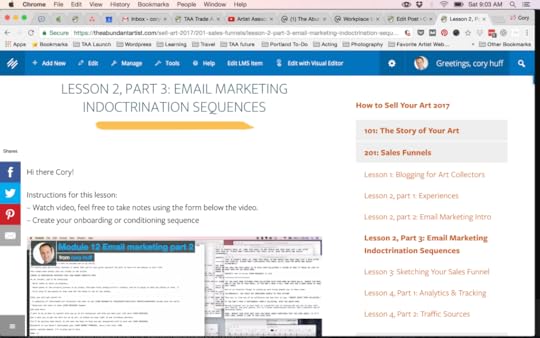Cory Huff's Blog: The Abundant Artist Goodreads blog, page 25
October 4, 2017
Anita Nowinska: A Case Study in Hard Work
From Cory: we run a private community for our course students, and Anita shared this a few weeks ago. We asked her if we could share because its a great example of what building an art business actually looks like. We’ve published it here with some light formatting and editing.
 “I had a bit of a revelation this week. I had to do my annual accounts, as a government incentive business advisor was coming today. For the first time ever, despite how many nebulous, creative and simply outrageous expenses I put down against the business as tax deductible ‘items and activities associated with research and materials for creating art’… I actually came up with a profit. And believe me… I’ve gotten away with some humdingers. The advisor did some fancy-pantsy program generated projection based on current activity, and decided that within the next 2 years, if I keep doing what I’m doing, I’ll be making the kind of money I’ve only dreamed of.
“I had a bit of a revelation this week. I had to do my annual accounts, as a government incentive business advisor was coming today. For the first time ever, despite how many nebulous, creative and simply outrageous expenses I put down against the business as tax deductible ‘items and activities associated with research and materials for creating art’… I actually came up with a profit. And believe me… I’ve gotten away with some humdingers. The advisor did some fancy-pantsy program generated projection based on current activity, and decided that within the next 2 years, if I keep doing what I’m doing, I’ll be making the kind of money I’ve only dreamed of.
So, I’m saying this not to brag but to give hope. One year, that’s 12 months, that’s only 365 days, can turn an art business around into a living.
How?
To begin:
I did all the TAA courses.
Then:
I slowly applied and did all the things suggested with no budget, just work.
I did some more work.
I didn’t watch TV or have a social life for myself.
I did some more work.
I learned that I can drink tea and eat lunch while working.
I streamlined what I was doing to eliminate wasted time.
I worked a bit harder.
I annoyed my son and my mother and became very unpopular by insisting they make their own tea, snacks, jelly, etc, and anything else that doesn’t absolutely, essentially require me. I made them look up for themselves on Google answers to all the questions they bombarded me with every 5 minutes and just accepted that if I’m to single-handedly support this family financially from my art, then they just have to give me the space to do it.
OTHER MARKETING
I behaved like a complete loon. I found ways of starting random conversations with complete strangers in parks, gardens, shop queues, etc. I managed to divert conversation to the fact that I paint. People find artists fascinating and hey, there always just happened to be a few business cards in my pocket and art on my phone (YES, I did actually sell something a few months later to a lady I’d gotten nattering to in a supermarket queue). My excuse when feeling shy or not confident? “I’M AN ARTIST, I’M ALLOWED TO BE ECCENTRIC! ITS EXPECTED OF US!”
DECISION MAKING
I realized that researching 3 ways of doing something was quite enough… then just pick one and get on with it. It can always be changed further down the line. Just live with it. Any more than 3, and it becomes an excuse not to get on with stuff and commit.
ADVICE
If I asked for advice from the TAA community or from someone, I learned to take the advice and either use it, or don’t ask the question again. Or realize that what I wanted to do in the first place was fine.
FINANCES
None, nada, zilch, literally. I borrowed money to do TAA. (note from Cory: we would never recommend that someone put themselves in debt to take our courses. We debated taking this out, but decided it would change Anita’s intent.)
I just did what I could myself. I went without stuff and just worked. I borrowed every penny for every course, exhibition, idea. I paid it back from sales from that investment.
When I ran out of money to feed my family, I stuck all my leftover prints and little pictures in the car and schlepped around shops and restaurants until I persuaded people to buy them.
DEMOGRAPHIC & CLIENTS
I went for the obvious, then the un-obvious, the downright ridiculous. I then refined it, then tried some wacky new things and found my audience through trial and error, ten squillion comments, engagements and shmoozing with complete strangers on Facebook, Insta, etc. I was constantly pushing the boundaries and trying new things without giving up.
MORALE
If I was feeling despondent or upset that things were not happening, I looked at everything I’d done, realized I was doing my best and accepted that that was all I could do. I saw that each day I had taken a step forward and that steps turn into miles.
I kept believing I could do it!
When I started to feel that the ‘work-work’ was demoralizing me, I did the fun work, the painting, and recorded it. I used it as work in progress for social media, etc.
Every few months I’d feel like my head was going to explode, so I’d get in the car and run away for a few hours and find a garden or beach to chill out in (usually sketching or taking photos to use for marketing).
I’d come back and start at it again.
I kept looking at what I had achieved, not at what I hadn’t!
Then I ramped it up and did some more work!
Hey, you know, before you say I CAN’T DO THAT, I just want you to know…
I am very conscious that I’m not writing enough blog posts.
I haven’t finished calling my whole PR list.
I haven’t perfected my website, I haven’t called enough influencers… lots of havent’s.
I haven’t done a thousand and one things I should be doing more of!
BUT THAT’S OK- I’M JUST DOING MY BEST!
I don’t whine or give myself a hard time. I just get on and do what I can, say a few prayers, and believe it will happen if I keep at it.
Anyone can do it!
Oh, and just as you think ‘Oh, she’s probably got all the time in the world,” I’m going to tell you something. NOT to say poor me, but to say IT DOESN’T MATTER, YOU CAN STILL DO IT.
I am a lone parent and support my child with learning difficulties and my elderly mother and the house. I homeschool my kid, and well. I have two very debilitating major health issues which give 24/7 pain. I just get on with it and don’t whine. My house is clean and tidy (most of the time).
I’m doing this with no other financial support and no help except the amazing support of the TAA community.
I AM NOT SUPERWOMAN… I’m an overweight 50 something artist with a determination do what I love most..paint! I just get on and do stuff.
So..if I can..YOU CAN!
Anita Nowinska is a painter based in the UK. You can see her work at Nowinska.co.uk.
The post Anita Nowinska: A Case Study in Hard Work appeared first on Online Marketing for Artists.
August 29, 2017
Billy Review: Accounting Software for Artists and Creatives
Accounting is the worst when you’re a solo business owner. Many artists feel like they’re not qualified to do their own accounting (which I completely understand and identify with). On top of that, accounting software is often very confusing, built for accountants and other accounting professionals. Billy aims to make life easier for the small business owner with a bifurcated approach. There are two views, one for the business owner, and one for the professional accountant who is helping you.

(Full disclosure: I’m good friends with the team that runs Billy here in the USA)
Billy Reviews
Lots has been written about Billy already. Capterra did an extensive review of accounting software options, ranking Billy as #2 in their list. Of the survey of the reviews that we read on Billy, and our own experiments with the software, here’s our thoughts on the software:
Inexpensive. Some accounting software (looking at your Xero) seems inexpensive, but when you want to add new features or perform a lot of reconciliations, costs can add up quickly. Billy’s price is reasonable and easy to understand.
Simple, not Simplistic. Quickbooks has been around forever, and they are a prime example of what software developers call “feature creep.” This is when customers, and other employees, request additional features that only a small number of people use, making the entire program more complex and difficult to use. Billy’s dual-view has many of the complex features that accountants want, but also the simplicity that business owners crave.
Responsive. Billy has been around for a number of years. It’s an established brand in Europe. I know the Billy team in the USA, and they are a crack team of professionals responsive to customer requests.
Lack of Network Effect. Billy’s one down side, which isn’t that big of a deal – many accountants and bookkeepers will ask you to move to their preferred software, which is often confusing and difficult to use if you’re not trained in it. If your preferred bookkeeper or accountant insists on their software, it probably won’t be Billy, since they’re new in the USA, but they are growing quickly.
Our Verdict
If you’re looking for easy to use accounting software for your art business, Billy has you in mind. Their product is solid. Lissie, my wife and the person who’s in charge of TAA financial operations looked at it and said it had everything she needed if we were looking to switch. It’s designed specifically for artists and will do what you need.
The post Billy Review: Accounting Software for Artists and Creatives appeared first on Online Marketing for Artists.
August 25, 2017
How to Make 6 Figures Teaching Art Courses Online – Professional Artist Magazine
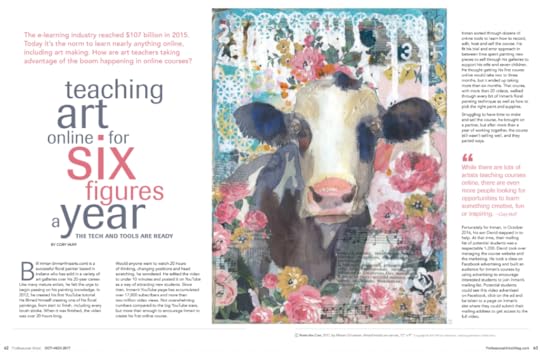 Screen shot from the article. Click the image to purchase a copy of the magazine.
Screen shot from the article. Click the image to purchase a copy of the magazine.
New article in Professional Artist Magazine about artists making six figures teaching online art courses. Article features Bill Inman Art and Miriam Schulman Watercolor Potraits. It also mentions Flora Bowley Paintings, Yimaukun Atelier, Donna Downey Studios, The Art of Amy T. Won, Wendy Hollender and Eschwan Winding.
Thanks to all the artist who contributed, this was a lot of fun to write.
Available wherever magazines are sold or here: http://bit.ly/2v8mhQL
The post How to Make 6 Figures Teaching Art Courses Online – Professional Artist Magazine appeared first on Online Marketing for Artists.
August 10, 2017
How the Fine Art Market is a Scam – Adam Ruins Everything & the Truth
I was already a fan of Adam Ruins Everything, a popular web series of 5 minute videos that show why conventional wisdom around various topics are wrong. Yesterday, they released this glorious video.
How the Fine Art Market is a Scam
The video is really short. I highly suggest you watch it. They highlight, in a hilarious way, the reality of the totally unregulated fine art market.
They also source their facts, referencing several high profile articles, which I dug up and linked to below.
High-end art is one of the most manipulated markets in the world (Quartz)
Valuable as Art, but Priceless as a Tool to Launder Money (NY Times)
They also reference the book The $12 Million Stuffed Shark, which is a fantastic, if chilling, read.
One other resource that I will add to the mix is the book Provenance: How a Con Man and a Forger Rewrote the History of Modern Art, which estimates that between 20% – 40% of all art on the market is forged.
What Individual Artists Can Do to Avoid These Scams
As an artist, the best thing you can do to avoid falling victim to art world scams is to cultivate your own following. Ideally, that is a mailing list, so that you have their actual contact information. Instagram and other social media are great, but you’re still playing by someone else’s rules there.
I can’t tell you how many successful artists I’ve spoken to who spent decades selling their art through galleries that then abandoned them or went out of business, leaving the artist with no one to sell to and no source of income.
Cultivating your own following does NOT mean becoming a scammy, spammy marketer. It means developing real relationships with potential customers, talking to people about the ideas that underpin your art, and being an approachable human being who cares about others, who is also unafraid to ask people to pay for your work.
It’s not glamorous. This is not what will get you into the big parties and written about on Page 6 – but it might get you into the MoMa, pay for your kids’ school, and help you make a difference in your own way.
There’s not a lot that an artist can do about wealthy power-brokers manipulating art prices. I’ve seen individual artists do is just completely refuse to play the game at all, or, as Mark Grotjahn did, play the game until you become famous, then begin forcing the dealers to play by your rules or stop producing art for them.
You can absolutely make a living from your art without the big dealers. You may not sell your art for millions of dollars, but you can make enough to live comfortably and be happy. Its not easy.
We talk about that a ton here at TAA. Long time readers already know that we offer hundreds of blog posts, podcasts, and other free content on making a living as an artist, including interviews with successful artists and art professionals.
We also built The Abundant Artist Association as a way of connecting artists who want this other path. Our members support each other, get access to business training and courses, as well as access to things like group health insurance discounts and legal help.
We built the Association precisely because so much of the fine art world is a scam. They don’t work in the interest of the artists – they work in the interest of wealthy collectors who are flipping art to make more money.
It’s about time artists take back control of their own industry, one artist at a time.
The post How the Fine Art Market is a Scam – Adam Ruins Everything & the Truth appeared first on Online Marketing for Artists.
August 9, 2017
Finding Your Unique Working Style
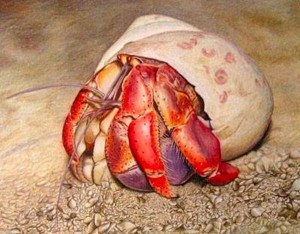 Everyone has a unique working style. For some, silence is key to productivity. For others, music or chaos is better for their ability to focus and get work done. Sometimes a person works best with a mixture of working styles and it can be difficult to figure out what works best for you.
Everyone has a unique working style. For some, silence is key to productivity. For others, music or chaos is better for their ability to focus and get work done. Sometimes a person works best with a mixture of working styles and it can be difficult to figure out what works best for you.Here’s just a few benefits of finding your unique working style:
You are able to be more efficient with your time (and get more done!)
You don’t feel like you’re banging your head against the wall because how your working is optimized to you
You feel like you have more energy because you’re working with your mind/body instead of against it or trying to force it to work in a way it doesn’t like
You can grow your art business more quickly because you’re able to be more productive!
For a long time I tried to schedule my time in order to boost my productivity. It failed. Miserably. I thought if I planned out my workday the night before, scheduling when I would work on what, it would streamline my process. It made sense that if I had a strict plan, I would get more done, similar to having an outline for writing. Unfortunately, I didn’t plan for my brain not being willing to work that way.
Instead of streamlining my process, I was blocked. I felt too confined and my brain wouldn’t focus on the tasks I had planned. I struggled to get anything done and would get frustrated with myself, not understanding that my failure to be productive was because I was trying to force myself to work a certain way.
It turns out my best working style requires me to have certain parts of my day be routine, like my morning tea while reading emails, and other parts dependent on how I’m feeling that day. Part of this is due to my chronic illness, which means some days I have more energy for work, and some days I need to rest. Because of these limitations and my preferred working style, I plan my weeks and days more loosely. I create a chart of things I NEED to do for the week, things I SHOULD do that week, and things I just WANT to do. Then I prioritize the things in my NEED list and work on each task as I can.
I also learned I work best in chunks, with a walk in the middle of the day to keep my mind fresh and my blood pumping. I get up every hour to get a drink. I walk around the house, I do some light yoga, or I get a snack, and then I’ll get back to work with fresh eyes and refreshed energy.
I thought silence would help me focus, and I was wrong about that too. It turns out music helps me focus on doing anything visual, and silence only helps me focus if I’m writing or reading.
Do you know how you work best?
Even if you think you know your working style, I suggest experimenting with multiple styles to see which one you really like best. Try working to music, have your studio a little messy, have your studio clean and organized, work in silence, work while listening to podcasts, get up and walk around, strictly schedule your time, loosely schedule your time, etc.
Sometimes your unique working style isn’t logical. Sometimes it doesn’t make sense. What you think should help you be more efficient with your time doesn’t always work best. Especially as artists, our working styles might not match that of someone who has a different job. We’re different. I find I’m just a little messier, a little more fly-by-the-seat-of-my-pants, and a little less afraid to take risks than the average person. I take more short breaks, and yet I get a lot of work done because I know this is how I need to work in order to be most productive. I know because I’ve tried just about everything and have learned what helps me maximize my productivity.
When it comes to your working style, don’t get caught up in thinking you have to work one way or another. Some days may be different than others. Some tasks may require a different working style than others. If you find you work best in pajamas on your couch, that’s okay. I know someone who discovered she needed to get dressed and then walk outside and around her house to enter her studio door from the back, as if she’s walking to work and pretend it wasn’t a part of her house. She found she needed to do this in order to feel like she’s at work, maintain a schedule, and not get distracted by being at home. That’s okay too! Find what works for you and you will be more efficient, productive, and happier with your work.
I’m chronically ill and have been since 2008. I’m much better now than I used to be, as I’m finally on a treatment that is slowly helping, but I still have strict limitations on what I can do and when I can do it. That’s why I’ve learned as many ways to be as productive as possible in my good time, and move my art business forward. There are a lot of techniques for productivity and building your business, which is what my new e-book, How To Build Your Art Business With Limited Time Or Energy , talks about in detail, and knowing your working style is an important one. If I hadn’t taken the time to learn my best working style, I wouldn’t be able to accomplish nearly as much.

Corrina Thurston is a professional wildlife artist specializing in detailed, vibrant colored pencil drawings. She began drawing in 2010, two years after falling chronically ill and having to medically withdraw from college. Corrina taught herself how to draw from her bed as a therapeutic outlet. It then blossomed into a profession. She has recently taken what she’s learned from her efforts of building her art business with her limited energy and written an e-book, How To Build Your Art Business With Limited Time Or Energy, to help other artists do the same. To learn more about her, feel free to view her website: www.corrinathurston.com.
The post Finding Your Unique Working Style appeared first on Online Marketing for Artists.
August 7, 2017
A $20 billion market you didn’t know about
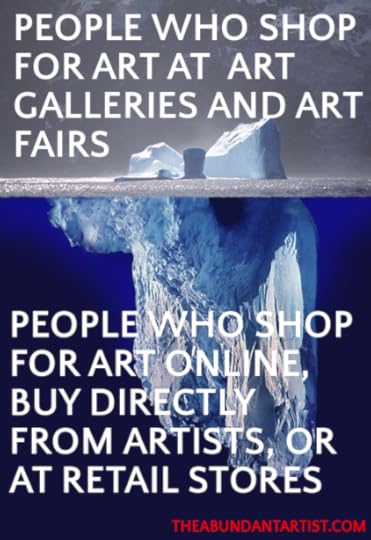 Over the last two weeks, I’ve been emphasizing that successful artists from big names like Picasso to more modestly successful artists have a community around them.
Over the last two weeks, I’ve been emphasizing that successful artists from big names like Picasso to more modestly successful artists have a community around them.
Let’s talk about how certain people take advantage of this need for outside help, and why artists need to stick together to tip the balance of power back in favor of the artist.
The art world has almost exclusively paid attention to the artists in the Blue Chip galleries, and they work together to make sure that the artists who get attention are only the artists in their galleries. They sponsor shows at the major museums where they are also donors. They develop relationships with the press that ensure that their artists are the ones that get written up by the major reviewers. Of the major art magazines, only a handful write about any artist outside the 10 largest metro areas.
But those artists in the blue chip galleries represent just a tiny fraction of all of the artists out there. The art industry calls those outsiders the “lower art market” because they don’t sell art for hundreds of thousands of dollars. But the lower art market is enormous. In 2016, over $45 billion of art was sold worldwide , and just $25 billion of that was the big galleries and auction houses. Everything else was the lower art market. That’s $20 billion that the art world is pretty much ignoring. Those sales don’t end up in the press, and when they do, its usually just a local newspaper or small magazine.
But where are those sales coming from? They are coming from the artist entrepreneurs. The individual artists who have decided that they would take control of their own destinies and learn how to run a business. They are artists who are making a living from their art on their own terms, without being told what to do by rich dealers who demand obeisance.
The point is that the numbers actually look really good for a new movement in the fine art world. The Internet has enabled once-ignored groups to band together and create change. People WANT to connect with artists who are making beautiful, creative, interesting, or challenging art. With so much mass commercialization happening, people WANT to have something original and handmade in their home.
And here’s the really devastating thing. Despite the fact that since 2007, over 25% of all art galleries have gone out of business, they’re not adapting. In 2016, a quarter of all galleries had no plans to adapt to the Internet. They’re either willfully blind, or they’re not paying attention. In 2016, more retail businesses went out of business than in the 2008 financial crisis, but at the same time, ecommerce grew by $40 billion.
The art world is not working to help artists. They’re working to make money for themselves.
ONE SOLUTION TO THIS PROBLEM
One of the reasons that the art market is the way that it is right now is that the art galleries have a strong incentive to keep it that way. They’re making a lot of money doing it this way. They de-emphasize other ways of selling, even to the point of threatening artists who want to do it on their own.
Another reason is that artists aren’t doing a good job of pushing back against this structure. There are a handful of artists who refuse to operate inside the gallery system. Hazel Dooney and Shirley Williams both left the gallery world, and their personal profits went up while their stress level and expenses went down. Gwenn Seemel and Owen Garratt never entered the gallery world in the first place.
There are actually lots of artists like this out there. We’ve interviewed and highlighted many of them.
But very few art magazines or art writers want to talk about this because it breaks the narrative.
TAA’s proposed solution to this problem is to join independent artists together to create a unified voice in the art world. One that supports artists who fully intend to make a living from their art. That’s what The Abundant Artist Association is all about.
We’ve created an organization that provides:
business training for artists in a way that is relevant powerful
a community that is exclusive to professional artists
discounts on group health insurance and legal help
advocacy with large organizations and governments on behalf of artists
Early enrollment bonuses end August 8 (that’s tomorrow). We would love to see you in there. Click the arrow or here to learn more.
The post A $20 billion market you didn’t know about appeared first on Online Marketing for Artists.
August 5, 2017
TAA Association Sneak Peek
We recently ran a short sneak peek behind the scenes into The Abundant Artist Association. The sneak peek is only the first 7 minutes. The rest of it is me answering specific questions about the Association and about selling art online.
For a full run-down of all features in The Association, please visit our sales page, but below, I’ve broken out a few key sneak-peeks.
The Community Site
We’re using Workplace, a standalone FB app, to run our community site. Here’s a quick screen grab (click to make larger). You can also see a real-time walk through in the video above, at 2:27.
This is the space where we hang out, ask questions, and discuss various topics. It works a lot like Facebook, but there’s no games or distractions from people who are not members of the Association.
The Courses
If you sign up for the full membership or the annual membership, you get access to some or all of our courses. Detailed at 3:54 in the video above, our courses are also detailed below.
How to Sell Your Art Online: the Courses
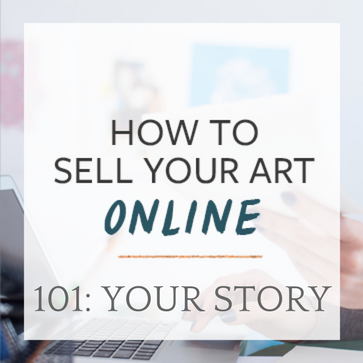
How to Sell Your Art Online 101: Your Story
HTSYAO 101 is intended for emerging artists who are still trying to figure out how to tell their story, who their target collectors are, and what their niche is in the art world.
Here’s How it Works:
As soon as you join the course, you’ll get a series of video lessons, transcripts, workbooks, and other resources to help you create – and grow – a success online art business.
This program will give you practical advice you can implement immediately, to get your first online art sale in 30 days or less – or if you’re already making sales, this program will help you double your sales in under a month.
Whether you’re just getting started, or you’ve been selling your work for years, you’ll get the exact strategies I’ve used to help hundreds of artists kick-start their online art sales.
Included in this Course:
Lifetime access to the entire course
5 Lesson Modules with videos, transcripts, and workbooks
Access to bi-monthly live coaching calls, including the opportunity to ask questions in advance.
A 2-month membership in The Abundant Artist Association, including access to a private online community of association members, monthly challenges, and legal assistance.
Exclusive bonus content including over 10 hours of recorded video and audio interviews with successful artists, access to an exclusive painting module from Scott Christensen’s best-selling ocean painting video course, access to Melissa Dinwiddie’s Great Clutterbust course, and The Abundant Artist’s printable Art Marketing Checklist.
How to Sell Your Art Online 201: Sales Funnels
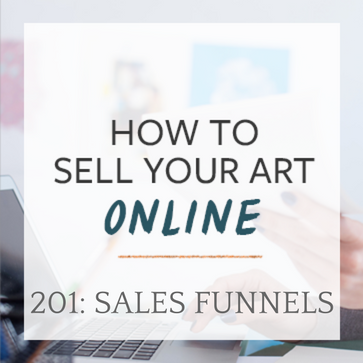
HTSYAO 201 is intended for artists who know how to tell a good marketing story and sell their art, who want to learn how to scale their business by building automated sales processes.
Here’s How it Works:
When you join the course, you’ll get a series of video lessons, transcripts, workbooks, and other resources to help you create automated, scalable systems for your art business, so you can start making money consistently and be able to live the life you want.
Need help knowing what to do at each step? There will be a decision tree in the course that will help you decide what to do at each step of your sales funnel. For example, if you have tons of social media followers, but you’re not getting many leads, we’ll help you brainstorm a few ideas to grow your sales leads.
Included in This Course:
Lifetime access to the entire course
4 Lesson Modules with videos, transcripts, and workbooks
Access to bi-monthly live coaching calls, including the opportunity to ask questions in advance.
A 2-month membership in The Abundant Artist Association, including access to a private online community of association members, monthly challenges, and legal assistance.
Exclusive bonuses, including a one-of-a-kind set of pre-written emails for marketing your art, access to Melissa Dinwiddie’s Great Clutterbust course, and The Abundant Artist’s printable Art Marketing Checklist.
How to Sell Your Art Online 301: Media & PR
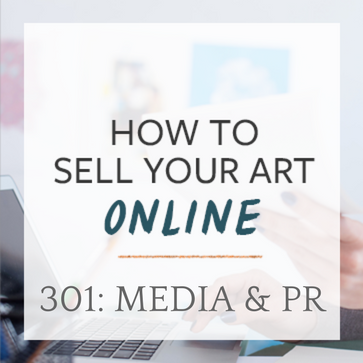 HTSYAO 301 is intended for artists who are looking for ways to drive lots of traffic to their websites, get more attention for their art, and make more sales.
HTSYAO 301 is intended for artists who are looking for ways to drive lots of traffic to their websites, get more attention for their art, and make more sales.
Here’s How it Works:
When you join the course, you’ll get a series of video lessons, transcripts, workbooks, and other resources to help you create automated, scalable systems for your art business, so you can make more money and have more fun talking to people about your art.
Need help knowing what to do at each step? There will be a decision tree in the course that will help you decide what to do at each step of your sales funnel. For example, if you have tons of social media followers, but you’re not getting many leads, we’ll help you brainstorm a few ideas to grow your sales leads.
Included in this Course:
Lifetime access to the entire course
4 Lesson Modules with videos, transcripts, and workbooks
Access to bi-monthly live coaching calls, including the opportunity to ask questions in advance.
A 2-month membership in The Abundant Artist Association, including access to a private online community of association members, monthly challenges, and legal assistance.
Exclusive bonuses, including pitch templates for media outreach, access to Melissa Dinwiddie’s Great Clutterbust course, and The Abundant Artist’s printable Art Marketing Checklist.
Artist Websites That Sell
 Artist Websites that Sell is intended for up-and-coming artists who need an effective and well-designed website that matches their artistic skill and will work to sell their art.
Artist Websites that Sell is intended for up-and-coming artists who need an effective and well-designed website that matches their artistic skill and will work to sell their art.
Included in this Course:
Video modules that will teach you how to fascinate your collectors by creating a unique visual brand that fits you and your work.
A photography and copywriting crash course on what kinds of photos to get, how to craft your website copy, how to gather testimonials, and legal stuff to include on your site so you are irresistible to your collectors.
Guides to the best WordPress, Squarespace and Shopify templates for artists and what makes them successful and profitable.
Exclusive bonus content including 3 example design briefs so you can see what website research and brand design looks like, and a checklist with everything you need to remember to include in your website.
Access to bi-monthly live coaching calls, including the opportunity to ask questions in advance.
This course is available as either a self-study course or with the addition of 30 minutes of personalized one-on-one coaching at the beginning and the end of the course.
Facebook Marketing for Artists
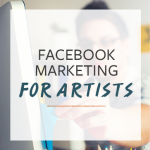
The content of the course has been refined over four years, and is focused on the questions asked by clients of The Abundant Artist. While we do cover the basics of how to get started, the majority of the course is designed to introduce you to the powerful tools that Facebook makes available – that almost no artists are using.
By the end of the class you’ll be stuffed with ideas on running your own Facebook marketing campaign. You’ll have set up and optimized your own artist’s Facebook page. You’ll be uploading images and updating your status like a pro, you’ll be interacting with your fans and followers, and you will be able to use Facebook’s massive advertising platform to grow your business.
Your Facebook page will be a fun, interactive place for your fans and collectors to hang out. And, most importantly, you’ll be on your way to creating your thriving online art business.
Included in this Course:
4 Lesson Modules with videos and full transcripts.
Exclusive bonus content including more than 50 example posts, ads, and more.
This course is available as either a self-study course or with the addition of an hour-long personalized one-on-one coaching session at the end of the course.
This is Our Best Deal
We are betting the future of TAA on the success of the Association. You can get access to all of these courses, as well as so much much, including our community, health insurance discounts, and monthly challenges.
I am confident that if you give us a shot, you won’t be disappointed.
The post TAA Association Sneak Peek appeared first on Online Marketing for Artists.
August 2, 2017
Internet Niche-Hunting: How to Find Your Audience
Every artist has an audience.
I know it doesn’t always seem that way. If you’re staring at a list of thirty Instagram followers consisting mostly of indifferent co-workers and Russian spam-bots – I can understand the incredulity at that opening statement. But it’s true.
The difference between the 30-follower artist and the one with 100k isn’t that one of them has an audience and the other doesn’t. It’s that one of them has been more successful in finding their audience. Being able to find an audience for your work is one of the most underrated skills of the successful internet artist.
But how do you find an audience? Well, it’s easier than you think. If there’s one thing the internet has in abundance – it’s people. That and cat pictures. But a lot of those cat pictures are posted by people. And chances are some of those people will probably like your art (especially if you paint cats).
When I first started posting my art to Instagram – I was constantly bogged down by a voice in my head shouting – “Who cares?”. Who cares about one more artist throwing their works onto Instagram? Who cares about how much work goes into anything I post? Who cares if my work is successful or is fated to disappear to the ether of the internet? Who cares?
The truth is – a lot of people care. And I’m going to show you how to find those people.
Getting featured on Instagram hubs
Instagram hubs are larger art profiles that cross-post art from smaller profiles. Getting your work featured on a hub can be a great way to boost your following. There are a ton of hubs on Instagram featuring works from varying aesthetics, so whether you paint illustrious saturated landscapes or take somber, monochromatic profile photos – you’re sure to find a hub that fits your niche.
This is the easiest way for a profile to get early exposure. Remember that these profiles already have an established audience who provide more engagement and more value to your posts. While some of these profiles may charge fees for cross-posts – there are some that will post your art as long as they believe it’s a good fit for their profile.
The hashtag brainstorm
Hashtags are how users on Instagram and Twitter discover new artists. If you go to a post by any successful artist on Instagram, you’re likely to see a list of hashtags flooding the bottom of their image description. It might seem a little cheesy at first – an artist reducing their work to easily-digested keywords and phrases – but it’s important for any artist to have them.
In a world where users are endlessly flooded with a flurry of options for curating the content that drips through their feed – hashtags make it easy for users to cut through the clutter of images to find users that they want to follow.
Picking the right hashtags for your posts can make a big difference in which users view your work. That’s why it’s important to research the hashtags that will allow you to target your niche and give them a chance to find your work.
Popular tags aren’t necessarily better
There are certain hashtags that are vastly more popular than others. For example, #art yields upwards of 2.7 million results. While these sorts of hashtags can be good for getting immediate exposure – it’s often too short-lived to be an effective way to gain followers. With so many users tagging their works with the same thing – it’s easy for your work to drown in a sea of posts.
You can use some popular hashtags if you want – but keep in mind that it’s going to be more important for your art to stand out in this case, since the exposure will be so short. Also keep in mind that you’re limited in the number of hashtags you can use, so it might be best to target more specific hashtags where you’ll get more prolonged exposure.
Picking the right hashtags
Now comes the question of which hashtags to use. You want the hashtags you use to be popular enough that users are actually exploring them but niche enough that you’re getting exposure out of them. If you plan on monetizing your account later on down the road – it also helps to think about trending business niches and how to use hashtags that will adhere to how you plan on monetizing your profile. You can find the right hashtags in a number of ways.
Start by exploring the hashtags that more popular profiles are using and see if your art would be a good fit for the Explore page under that hashtag. Have a document open on your computer while doing this so that you can track which hashtags you’d like to use. There’s also free tools like Display Purposes that you can use to explore hashtags related to the ones you already have.
The idea is to compile a list of keywords and phrases that best describe your art to the audience you’re seeking. Once you start using these hashtags, you’ll start to notice more followers and more engagement on your posts – which helps to boost them in the feed of users already following you.
Engage with like-minded profiles and their followers
Hashtags are important – but they’re not the only way to find your audience. Chances are if you’re looking to start promoting and selling your art on social media, you’re already following artists with niches similar to yours.
It’s likely that users who follow these artists will be interested in your work as well. Start by identifying accounts similar to yours that might have more followers. If you’re already using your hashtags – you can find these accounts by viewing the feed for one of the hashtags and checking out the most popular posts for that tag.
From there – find some artists you think would have followers that might like your art as well. Generally this is as easy as picking the artists that you like the most. Keep in mind that artists don’t need to have your exact style and aesthetic – but an audience that would cross over significantly with yours.
Engage with your prospective followers
Once you have some followers – engage with them. This means liking and commenting on their posts and following some profiles that are most interesting. Remember that Instagram is a community. You’ll find that as you start to engage with users – they’ll engage with you back.
You’re likely to get a handful of follows out of this as well as likes and comments. Remember that Instagram determines the value of a post by its likes and comments – which means that having users engage with you is also going to boost your visibility on top post pages and other users feeds.
Every artist has an audience. Hunting for your niche on social media can seem daunting – but take it from me that it’s worth it. The more focused and more evolved your campaign to find followers is – the more successful you’ll be as an artist on Instagram.
—
HarveyStewart is a writer and digital artist based in Toronto, Canada. He’s written about content marketing, futurism and technology. He graduated from York University in 2012 with a degree in Journalism.
The post Internet Niche-Hunting: How to Find Your Audience appeared first on Online Marketing for Artists.
August 1, 2017
The Best Printers for Printing Your Art at Home
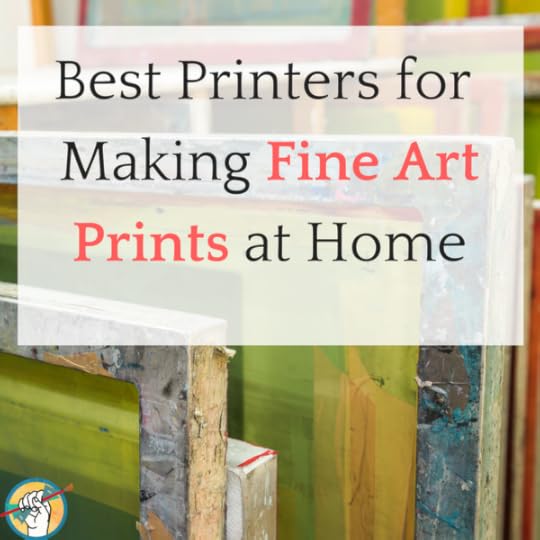 If you’re creating prints of your art at home to sell at shows and online but balking at the quality you get from that $40 laser printer, you have a couple of options. The first is to outsource your printing to a local print shop. Of course introducing the hassle of an extra errand (not to mention the extra cost) into your schedule may be too much. You can also move your operation to a print-on-demand website, but for the tradeoff of letting someone else take care of the printing and shipping you sacrifice a huge chunk of the profit.
If you’re creating prints of your art at home to sell at shows and online but balking at the quality you get from that $40 laser printer, you have a couple of options. The first is to outsource your printing to a local print shop. Of course introducing the hassle of an extra errand (not to mention the extra cost) into your schedule may be too much. You can also move your operation to a print-on-demand website, but for the tradeoff of letting someone else take care of the printing and shipping you sacrifice a huge chunk of the profit.
The third option, for artists who find themselves needing to frequently print high-quality images of their art for prints or marketing materials, is to invest in a good printer. We chatted with some artists in our Mastermind group to get the inside scoop on the best printers out there for busy artists.
Canon PIXMA Pro9000 Mark II Inkjet Photo Printer
Canon PIXMA PRO-10 Color Professional Inkjet Photo Printer
Amelie also loves her Pixma- “I love it. You can get archival ink for it or you can get compatible non archival alot cheaper….all depends what your needs are.“
Epson Stylus Photo R2000 Wireless Wide-Format Color Inkjet Printer
Epson SureColor P600 Inkjet Printer
Epson Artisan 1430 Wireless Color Wide-Format Inkjet Printer ($339) – At the lowest price point on this list, the Artisan 1430 still provides many of the same features as some of the more expensive models including wide-format printing and 6-color ink. It also offers color and lighting correction. TAA artist Debbie uses this one for smaller prints and loves it. Gilat says “I invested in an Epson Artisan 1430 last year. I go through a lot of ink when I create batches of prints, but I love the control and doing everything from my home studio.“
The post The Best Printers for Printing Your Art at Home appeared first on Online Marketing for Artists.
July 31, 2017
Why Join The Abundant Artist Association?
Last week I asked the members of TAA Association why they joined. Here’s a brief rundown of what they said. Here’s my live video that I did last week.
“I signed up for the Association to be part of a wider community” was a common refrain heard through out the discussion. When I asked what this means to them, this was one artist’s response.
“I sometimes feel isolated with questions that my non-artist friends and acquaintances may not understand and/or be unable to answer. In an association, there is a commitment, a support network focused around common interests, the creative process and other topics which matter to artists wanting to go professional.”
I don’t think I could possibly sum up what we’re trying to do here better.
I’ve been running TAA for 8 years. When I started it was all about the knowledge. I wanted to teach online marketing to artists, because that’s what they were asking me to teach.
But over the years, I noticed that artists were saying, over and over again, that they were isolated. They didn’t know other artists. They couldn’t move to NYC to be a part of the scene there because they had family or other commitment where they were, and they didn’t know how to find a local scene.
Several artists said they wanted to see “how other artists are succeeding,” or to “find a community of working artists, so we can share tips, successes, failures, and generally support each other.”
I also like what one artist said about wanting “to engage a community of artists (to advance the awareness of upcycled art).” If you make a type of art that is a bit unusual, you have to make people aware of it and educate them a bit on why it matters. A community of similarly interested artists certainly helps with that.
In our presentation on how artists use community last week, I talked about how, in 1867, Claude Monet saw that the fine art business was tilted against artists who were doing original, innovative work. He got together with then-unknown artists like Degas, Manet, and others to put on their own show, outside the French Academy, and it was a huge success, birthing Impressionism. It was called the Co-operative Company of Artists, Painters, Sculptors, Engravers. Movements like this happen over and over again, with the American Armory show, the Young British Artists, and many more.
One artist said that she liked our idea of “emulating the impressionists and actually building something new for ourselves. With the internet, we can get artists together from all over the globe, and we can all share ideas and support each other. I always loved the thought of the old salons, and it would really be something if we could build something like that here.”
That’s the goal. 
The Abundant Artist Goodreads blog
- Cory Huff's profile
- 31 followers



